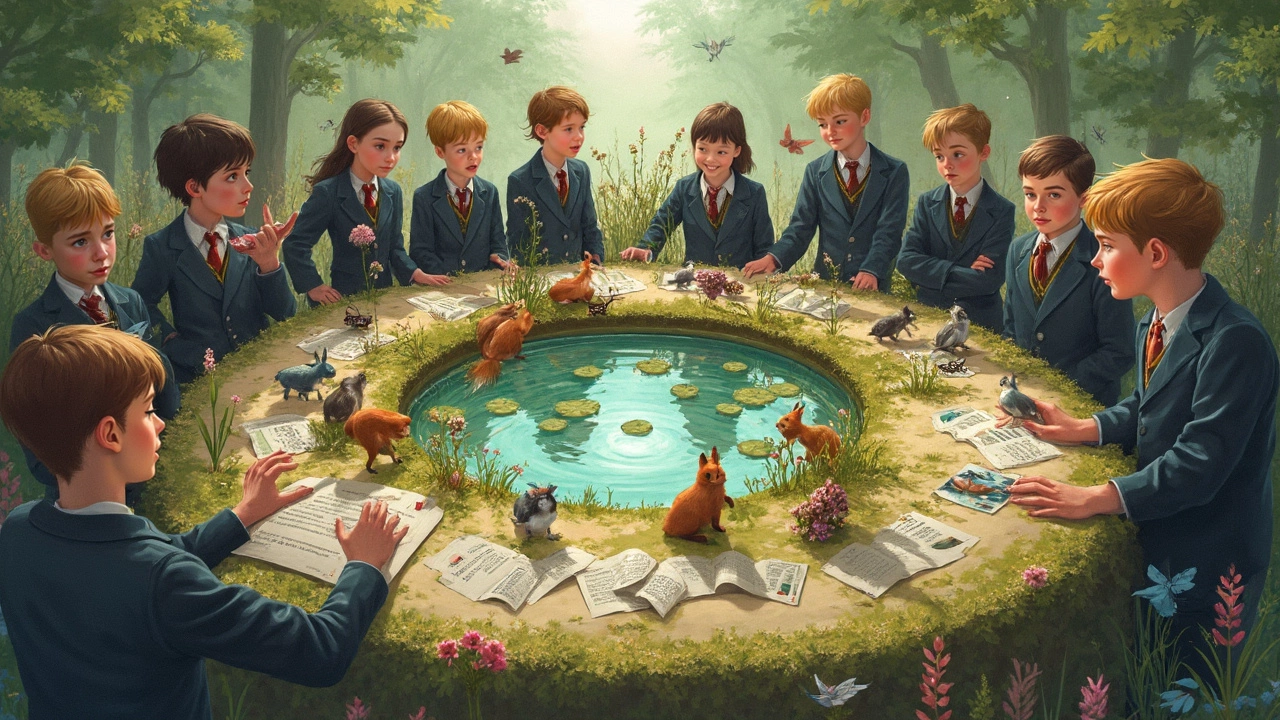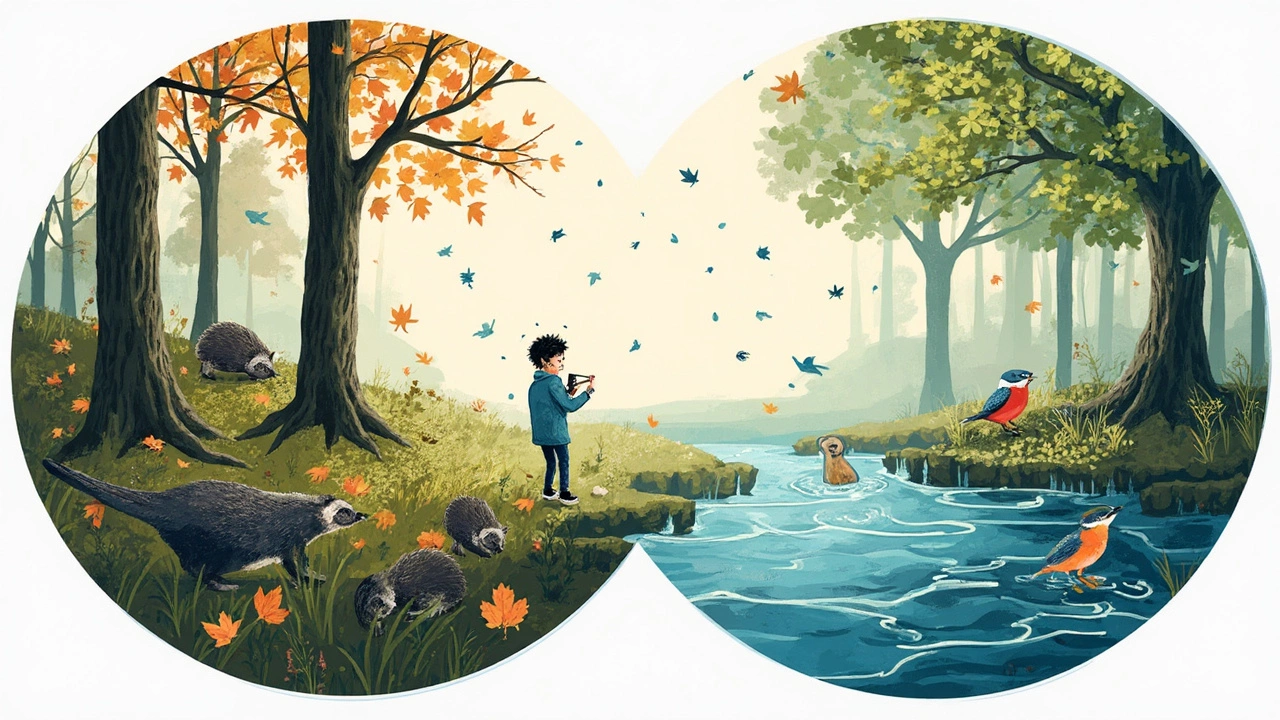Main Groups of Ecosystems: Terrestrial vs Aquatic Explained Simply
 Jun, 21 2025
Jun, 21 2025
Think of the natural world as one big puzzle. The pieces? Ecosystems. But not all ecosystems are built the same way. The whole planet’s living spaces fall into just two main groups: terrestrial (on land) and aquatic (in water).
What’s the difference, and why does it matter? If you spend your weekends hiking, you’re moving through terrestrial ecosystems like forests, grasslands, or even deserts. Love the beach or fishing in a lake? That means you’re part of an aquatic ecosystem for the day. Everything from the animals you see to the air you breathe is shaped by which group you’re in at that moment.
This split isn’t just for textbook sorting. Knowing about these two big divisions helps you understand why certain plants and animals are found where they are, and how they all link up to your everyday life. Stay tuned for some factoids and tips that might change how you think about your next walk in the park or swim at the pool.
- Ecosystem Basics: What Makes an Ecosystem?
- Terrestrial Ecosystems: Life on Land
- Aquatic Ecosystems: Water Worlds
- Why These Groups Matter to Us
- Easy Ways to Support Both Types
Ecosystem Basics: What Makes an Ecosystem?
An ecosystem is just a community of living things—like plants, animals, even tiny bacteria—interacting with each other and with their non-living surroundings. Stuff like sunlight, water, rocks, and air all count as part of the setup. It doesn’t matter if it’s a rainforest in Brazil or a backyard pond in Wisconsin—these spots are all ecosystems doing their thing.
Each ecosystem has four main parts:
- Ecosystems always have producers (such as green plants) that make food from sunlight.
- Consumers, such as animals, eat the plants or other animals.
- Decomposers like fungi and worms break down dead matter and recycle nutrients.
- The non-living bits: sunlight, air, soil, and water.
What’s cool is that these systems balance themselves, most of the time. If there are suddenly too many rabbits eating grass, predators like foxes help keep numbers in check. If something throws off that balance, like an oil spill in a river or a drought on the prairie, the health of the whole system can take a hit.
Scientists can study ecosystems of all sizes, from a patch of moss on a rock to a huge ocean. Wherever living things are mixing it up with their environment, you’re looking at an ecosystem. And the two main groups—terrestrial (land) and aquatic (water)—cover pretty much everything out there.
Terrestrial Ecosystems: Life on Land
You experience terrestrial ecosystems every day—just look outside your window. These giant zones are found on land and cover everything from the Amazon rainforest to the Sahara Desert. They’re shaped mostly by climate, soil, and which plants and animals can tough it out there.
Here’s something wild: about 29% of Earth’s surface is land, and all of it hosts some kind of ecosystem. That might not sound like much, but it’s home to millions of species, including humans, dogs, squirrels, elephants, and oaks. A forest, a grassland, a desert, and even mountain slopes all count as types of terrestrial zones.
Let’s get specific. Here are some common terrestrial ecosystem types you might know or even visit:
- Forests: These include tropical rainforests (like in Brazil), temperate forests (the kind you might see on a North American road trip), and boreal forests (think Canada or Russia).
- Grasslands: Like the prairies in the USA or the savannas in Africa, these areas are perfect for grazing animals but have fewer trees.
- Deserts: Not just endless sand—many deserts have cacti, tough shrubs, and surprising animal life that’s great at conserving water.
- Tundra: The cold, treeless zones near the north and south poles. Mosses and lichens rule here, along with hardy animals like caribou.
Why should you care? Because these land-based environments do some heavy lifting:
- They suck up carbon dioxide and help fight climate change (forests are champions at this).
- They make the air we breathe cleaner.
- They support crops, wildlife, and our everyday lives.
Want a quick peek at how these types stack up? Check the table below for the biggest terrestrial ecosystems and how much of Earth they cover:
| Ecosystem | Percent of Land Area |
|---|---|
| Forests | ~31% |
| Grasslands | ~25% |
| Deserts | ~33% |
| Tundra | ~8% |
With weather shifts and human activity, some of these areas are shrinking fast. Things like planting trees, cutting back on waste, and supporting local conservation can actually help keep these systems in balance. If you’re picking where to hike or travel, maybe pay attention to how these lands are being taken care of.

Aquatic Ecosystems: Water Worlds
When people picture aquatic ecosystems, they usually think of oceans, but there’s a lot more to it than just saltwater. Aquatic ecosystems include all water environments — that means oceans, rivers, lakes, ponds, streams, and even wetlands. These systems are split into two big types: freshwater and marine. Freshwater is what you find in lakes and rivers, while marine covers all the salty spots, like seas and oceans.
Here's a fun fact: Oceans cover about 71% of the Earth's surface. That’s most of the planet, and nearly all of it is considered part of the marine ecosystem. But freshwater ecosystems, while only making up about 2.5% of earth’s water, are home to a huge chunk of biodiversity. Think about the tiny streams in your neighborhood — they can have a major effect on bigger rivers and even coasts far away.
One cool thing about aquatic life is the way everything is connected. Fish, plants, and even microscopic plankton all depend on each other. For example, wetlands filter pollution before it can enter rivers and lakes, kind of like nature's water Brita. And did you know the Amazon River dumps enough fresh water into the Atlantic every day to fill over 80,000 Olympic-sized swimming pools?
| Type | Main Features | Example |
|---|---|---|
| Freshwater | Low salt, often moving water | Lakes, rivers, ponds |
| Marine | Salt water, tides, massive scale | Oceans, seas, coral reefs |
It’s not just about animals either. Aquatic plants like seagrass, kelp, and mangroves provide food, shelter, and even help stabilize coastlines against storms. Coral reefs, which are found in warm marine waters, support about 25% of all ocean life, even though they take up less than 1% of the ocean floor. That’s like a tiny apartment building that somehow houses a quarter of the city’s population.
- If you like snorkeling or fishing, always avoid damaging the plants and corals — they’re way more important than they look.
- Stick to local rules about bait and invasive species. Even a small introduction of a new fish or plant can cause big trouble for local ecosystems.
No matter where you live, what happens upstream or far out to sea can actually circle back and affect your drinking water, seafood, and even the air you breathe. Makes you think twice about how connected we all are, right?
Why These Groups Matter to Us
It’s easy to forget how much we depend on these two groups of ecosystems until you look at what happens when they’re out of balance. Terrestrial and aquatic ecosystems don’t just sit quietly in the background—they do a lot of heavy lifting for the planet and for us.
For starters, terrestrial ecosystems like forests and grasslands act as Earth’s lungs. Forests, in particular, absorb carbon dioxide and pump out oxygen—so every time you catch a deep breath, you should thank a tree. According to NASA, forests suck up nearly 2.6 billion tons of carbon dioxide every year, which helps fight climate change.
Ecosystems in the water are no less impressive. Healthy aquatic systems like rivers, lakes, and oceans clean our water, support fishing, and help regulate weather patterns. About 3 billion people rely on seafood as their main source of protein, and oceans absorb about a quarter of the carbon dioxide people release into the air.
So, what happens when one group is in trouble? Problems don’t stay local. Destroying a wetland can lead to flooding in your town. Cutting down forests can mean hotter cities and poor air quality far from the nearest tree. Even if you live miles from the shore, you’re still connected with what goes on in the sea and vice versa.
- If you notice fewer bees, it could be because pesticides in farm fields (a land issue) are running off into aquatic habitats.
- Algae blooms in lakes and oceans—those odd green patches—often start with fertilizer runoff from farms or lawns.
All in all, these groups matter because their health decides whether we have clean air, drinkable water, and a climate that isn’t totally off the rails.

Easy Ways to Support Both Types
If you care about keeping our planet in balance, there are simple things you can do to support both land and water ecosystems—no PhD required. You don’t need to join a big group or make huge life changes. Even small choices add up fast.
Start at home. People often forget that what goes down the drain in your house can affect lakes and rivers miles away. Use eco-friendly cleaning products and skip the harsh chemicals. According to the Environmental Protection Agency, "runoff pollution is one of the biggest threats to aquatic life," so keeping trash and chemicals out of storm drains goes a long way.
When you’re outside, think about where your trash lands. Plastic bags and bottles thrown on a trail or beach can end up choking animals or breaking down into microplastics that mess up food chains. Spend a few minutes picking up litter, or join a local cleanup. My friend Gina once said after a Saturday cleanup, "It’s wild to see how much garbage piles up in just one area—I never walk past a wrapper now without grabbing it."
Save some water. Whether you’re living in the suburbs or in the city, water conservation helps both ecosystems. Shorten your showers, fix leaky faucets, and water your plants early or late so less water evaporates. It’s not just about your bill—these steps actually keep more water in rivers and wetlands.
Here are a few more things you can try right away:
- Eat more plant-based meals. Producing veggies and grains takes less land and water than raising livestock.
- Plant native trees or flowers. They pull in more local insects and birds, and use less water compared to exotic plants.
- Skip unnecessary lawn chemicals. Fertilizers and pesticides can end up in nearby streams and harm aquatic life.
- Support local or national parks—when possible, donate or volunteer. These areas protect both kinds of ecosystems.
- Talk with your friends and family about why these steps matter. Sometimes a casual chat is all it takes to spark change.
Each tip might feel small, but if you try just one, you’re already making a difference. Keeping those two main groups healthy isn’t out of reach. It just takes a few tweaks in how we all do things day-to-day.
